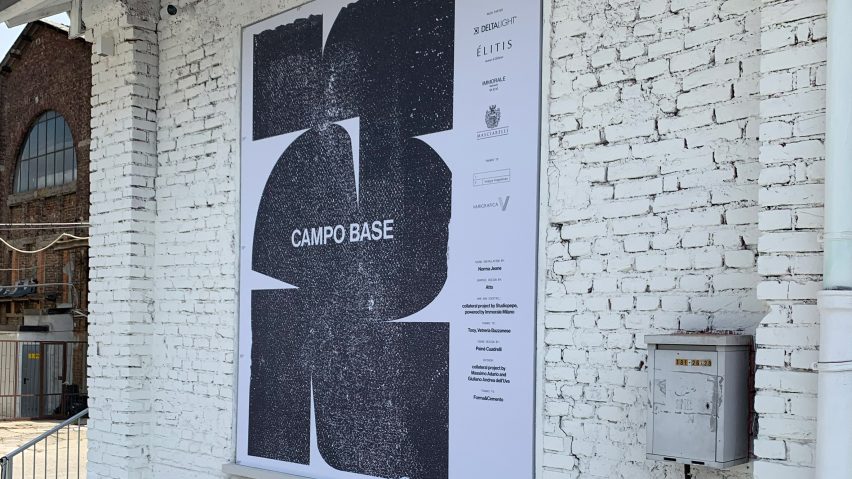
"I embrace the opportunity to learn from my mistake" says Massimo Adario
Architect Massimo Adario curator Federica Sala have apologised for displaying a collection of 1920s glass figurines at Milan design week that were described as "embodying racist stereotypes".
Adario apologised for the display following criticism from designers including Stephen Burks and Anava Projects.
"First of all, I would like to apologise to all those who have been hurt and offended by my project," he told Dezeen.
"It was absolutely not my intention to inflict harm nor offence," he continued. "I invite anyone who has suffered to engage with me to help me understand the different worlds and cultures from which each of us comes in the belief that only knowledge and empathy are the true antidote to racism."
"Racism is not fought by destroying works of art"
The figurines, which were displayed as part of a show called The Collector at an exhibition called Campo Base, were described as "racist" in a series of posts on Instagram by Burks and Anava Projects and PR agency Hello Human.
Italian architect Adario displayed the hand-blown glass figurines with exaggerated features and colours, which were made by the Industrie Vetraie Artistiche Murano glassworks factory in Venice in the late 1920s, in a glass cabinet within a tented space.
View this post on Instagram
Burks, Hello Human and Anava Projects criticised the exhibition on Instagram
Adario explained that he believes that historic pieces, like those that he displayed, should not be ignored.
"From my perspective as an Italian, racism is not fought by destroying works of art," he said.
"Our artistic heritage has such historical depth and breadth, which fortunately helps us to give context, and not to judge only with the eyes of the present moment," he continued.
"The problems of our society – including the scourge of racism – are not solved by censoring or obliterating works of art that have since become questionable, or even offensive; but rather by continuing to believe in and guaranteeing the right to engage in vigorous debate about what originated them, the historical context to which they belong, and how today's fuller knowledge, understanding and appreciation can and should re-elaborate their meanings and significance."
The exhibition had draw widespread attention following Milan design week due to posts on Instagram by Burks, Anava Projects and Hello Human.
"Such 'decorative motifs' have a long and shameful history in our field," said the group. "It was shocking to see this history so casually evoked in a contemporary design project."
Racism is a big problem
Burks, Anava Projects and Hello Human expressed a desire to have greater dialogue over the project and wider issues of racism in the design industry.
"What has become very apparent from various conversations we have had with various people in our industry, is that many still do not understand why these figures are so deeply offensive," they said.
"There is a clear lack of communication and dialogue happening within the design industry, something we desperately need all roles within the industry to work on in order for this not to happen again."
In response, Adario agreed that "dialogue should always be the basis for problem-solving".
"Raising ideological barricades, in my opinion, may help a single individual feel like he/she/they is/are taking a stand and contributing to solving a problem; when in reality it does not help arrive at a collective, shared understanding of an issue," he said.
"And racism is a big problem, which – in my case – also needs to be framed culturally."
"I am deeply sorry"
The exhibition was displayed as part of the wider Campo Base exhibition, which was curated by Federica Sala and included work by six architecture studios – Massimo Adario, Giuliano Andrea dell'Uva, Eligostudio, Marcante-Testa, Hannes Peer and Studiopepe.
However, Adario explained that the project was entirely his concept.
"I take full and total responsibility for my work and for my words," he said. "Everyone else should not be involved or tarnished by my actions."
"I embrace the opportunity to learn from my mistake, together with anyone of those in the wider design community who share an ideal of open, transformative dialogue, so that racism and its roots be confronted and rejected wholeheartedly," he continued.
"Above all, I hope that it will make clear that there was no racist intent in it. I am not racist. I hate racism."
"Again, I am deeply sorry that this project has hurt the sensitivities of communities from other countries and other cultures, including surely some also here in Italy. That was absolutely not my intention."
Curator of Campo Base Federica Sala also responded to the original story.
"We regret what happened and we apologies for the discomfort this have caused, she said. "It was by no mean intentional to offend anyone and we don't want to minimise this."
"These pieces are from 1920-27 and are from the personal archive of Massimo Adario's that had an Italian historical contest in mind," she said. "We didn't perceive these pieces on a global scale and that is our mistake. We absolutely stand against racism and other forms of prejudice. It is our intent to listen and learn from this experience as our objective was not to create division or conflict."